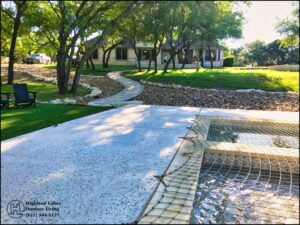What is Hardscaping?
Hardscaping refers to the “hard” materials used in landscaping, as opposed to “soft” elements like plants, soil, and grass. It includes pathways, patios, retaining walls, outdoor kitchens, fire pits, and water features. It involves the use of non-living elements like stone, brick, concrete, and wood to define the structure and layout of your yard or garden. There are numerous advantages of hardscaping that can transform your outdoor area into something both practical and stunning.
For example, if you have a stone outdoor kitchen as part of your outdoor living space, hardscaping not only supports its structure but can also elevate its look by incorporating stone pavers, elegant walkways, and well-crafted seating areas. For more Custom Kitchens from Highland Lakes Outdoor Living, look here: Stone Kitchens
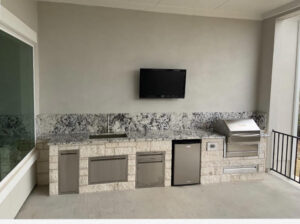
Benefits of Hardscaping
Hardscaping adds numerous benefits to your outdoor space beyond its immediate visual appeal. Here’s why you should consider incorporating hardscaping into your next project:
- Increased Property Value
One of the key advantages of hardscaping is the increase in property value. Potential buyers are often attracted to properties with professionally installed outdoor features like patios, fire pits, and stone pathways. - Low Maintenance
Once installed, hardscaped areas require minimal upkeep compared to lawns and gardens. You don’t have to worry about watering, pruning, or fertilizing—just the occasional cleaning to maintain the structure and appearance. - Durability
Stone, brick, and concrete are built to last. Unlike wooden decks or softscapes, hardscaped surfaces can withstand weather changes, from summer heat to winter frost, without significant deterioration.This durability is one of the core advantages of hardscaping, ensuring your investment lasts for years. - Erosion Control
Hardscaping can help combat erosion by creating solid barriers, such as retaining walls, that stabilize the soil. This is especially helpful if you live in a hilly or sloped area, where soil erosion is a common issue. - Defined Spaces
One of the biggest benefits of hardscaping is its ability to define outdoor spaces. Whether it’s a patio for lounging, a path that leads to your garden, or a custom kitchen setup, hardscaping gives structure and flow to your yard.
Hardscaping Ideas for Your Outdoor Space
- Patios and Decks: A beautiful patio can serve as the heart of your outdoor space. Stone, concrete, or paver patios provide a sturdy and attractive foundation for outdoor furniture, grills, or a stone outdoor kitchen.
- Walkways: Create a path that leads visitors from your front yard to your backyard, garden, or other outdoor features. Walkways not only improve navigation but also exhibit one of the aesthetic advantages of hardscaping by adding depth and visual interest to your outdoor design.
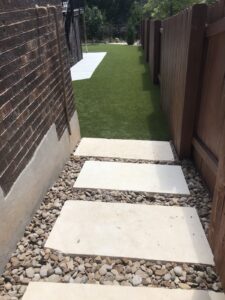
- Retaining Walls: These are both practical and aesthetically pleasing. Retaining walls made from natural stone or concrete not only prevent soil erosion but can also double as seating areas or garden beds.
- Outdoor Fire Pits: A fire pit can be the perfect gathering spot for family and friends during cooler months. Stone or brick fire pits add warmth and visual interest to your backyard, making it an inviting space year-round.
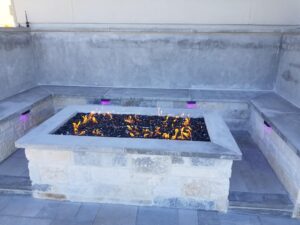
- Water Features: Incorporating a fountain, pond, or waterfall into your hardscape can create a calming atmosphere.They also highlight the advantages of hardscaping by seamlessly integrating natural elements with constructed ones.

Choosing the Right Materials
The materials you choose for hardscaping depend on the overall look and feel you want to achieve. Natural stone provides a timeless, rustic appeal, while concrete can be molded into modern, sleek designs. Brick offers a classic, warm look that works well with traditional homes, and wood can be incorporated for a more natural aesthetic, particularly for elements like pergolas or benches. Here is a link to the different types of stone and bricks commonly used in Texas: Texas Stones
When designing your hardscape, consider how the materials will complement the softscape—trees, shrubs, and flowers—in your yard. The right balance between hard and soft elements will create a harmonious, cohesive outdoor environment.
Conclusion
If you’re ready to transform your yard, reach out to Highland Lakes Outdoor Living to explore all the options for custom hardscaping solutions. With the right design, your outdoor space can be a personal oasis where you relax, entertain, and enjoy nature year-round.
Check out some of our past projects with Hardscaping:
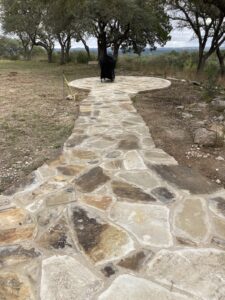 .
. 